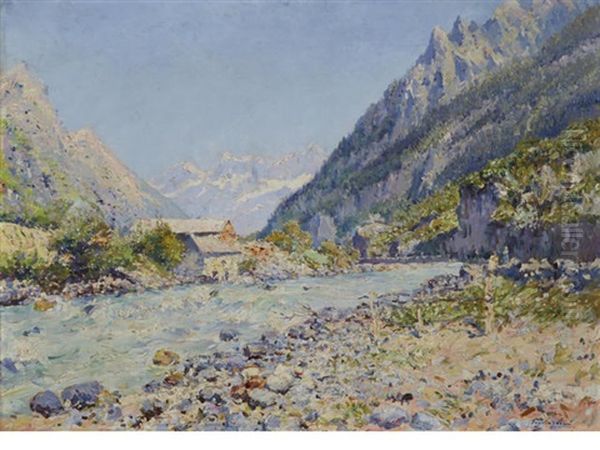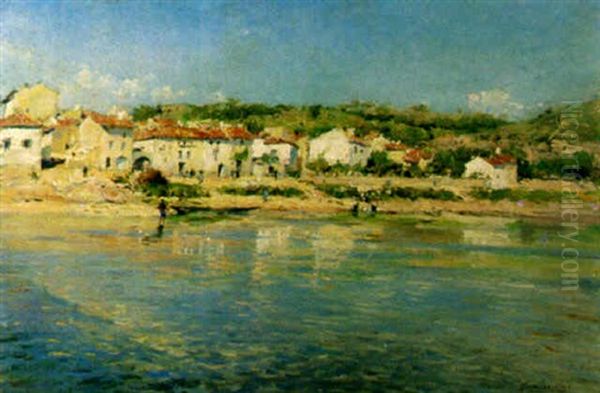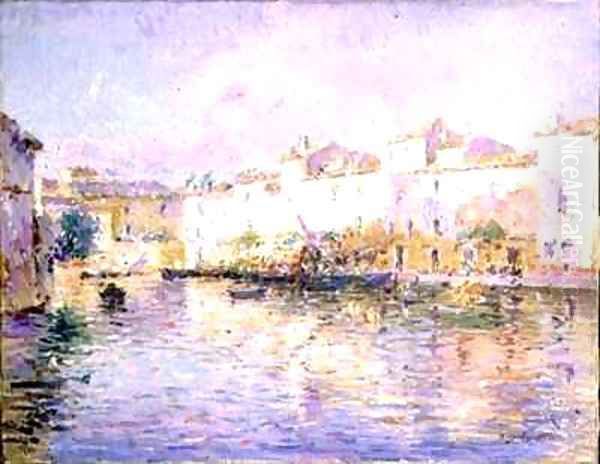Julien Gustave Gagliardini (1846–1927) stands as a significant, if sometimes overlooked, figure in the vibrant tapestry of late 19th and early 20th-century French art. A painter of considerable skill and versatility, Gagliardini navigated the evolving artistic landscape of his time, earning accolades and a respectable place in art history, primarily for his evocative landscapes that captured the luminous beauty of southern France. His journey from an aspiring artist in Paris to a celebrated Salon exhibitor reflects both the academic traditions of the era and the burgeoning appeal of Impressionistic sensibilities.
Early Life and Artistic Formation
Born on March 1, 1846, in Mulhouse, a town in the Alsace region of eastern France, Julien Gustave Gagliardini's artistic inclinations emerged early. His family background, though not extensively documented in common art historical records, likely provided an environment where his talents could be nurtured. Seeking formal training, Gagliardini made his way to Paris, the undisputed epicenter of the art world in the 19th century. This move was crucial for any aspiring artist aiming for recognition and a professional career.
In Paris, Gagliardini enrolled at the prestigious École des Beaux-Arts, the leading art institution that upheld the classical and academic traditions. Here, he had the distinct privilege of studying under Léon Cogniet (1794–1880), a highly respected historical and portrait painter and a prominent member of the French Académie des Beaux-Arts. Cogniet, known for works like Tintoretto Painting His Dead Daughter and his portraits of notable figures, would have instilled in Gagliardini a strong foundation in drawing, composition, and the meticulous techniques favored by the Academy. The provided information also suggests he studied under a painter named Soulary in Saint-Étienne and Paris, though Cogniet remains the more widely recognized and influential of his mentors within the academic system. This rigorous training emphasized anatomical accuracy, balanced compositions, and a polished finish, hallmarks of the academic style that dominated the official Salons.
The Parisian Salon and Early Career

The Paris Salon, organized by the Académie des Beaux-Arts, was the most important art exhibition in the Western world during the 19th century. Acceptance into the Salon was a critical step for an artist's career, offering visibility, potential sales, and critical recognition. Gagliardini made his debut at the Salon in 1869. Initially, his submissions focused on figurative works, including portraits and genre scenes—subjects that were well-regarded within the academic tradition and often showcased an artist's technical prowess in rendering human form and narrative.
However, Gagliardini's artistic interests began to evolve. While he continued to produce genre scenes and historical paintings, a growing fascination with the natural world and the effects of light led him increasingly towards landscape painting. This shift was not uncommon among artists of his generation. The Barbizon School, with painters like Jean-Baptiste-Camille Corot and Charles-François Daubigny, had already popularized landscape painting in the preceding decades, emphasizing direct observation from nature. Furthermore, the Impressionist movement, which held its first independent exhibition in 1874, was radically transforming the perception and execution of landscape art, championing plein air (outdoor) painting and the subjective experience of light and color.
Gagliardini, while not a radical Impressionist in the vein of Claude Monet or Camille Pissarro, was undoubtedly aware of these currents. His transition towards landscape painting after his Salon debut suggests an artist responding to both personal inclination and the changing artistic climate. He found a way to incorporate some of the vibrancy and light-filled qualities associated with newer trends while maintaining a degree of compositional structure and finish that remained acceptable to Salon juries.
The Lure of the South: Provence and Auvergne
A significant portion of Gagliardini's oeuvre is dedicated to the landscapes of southern and central France, particularly the regions of Provence and Auvergne. These areas, with their distinctive topography, intense sunlight, and picturesque villages, offered a wealth of inspiration. Provence, in particular, with its ancient Roman ruins, olive groves, lavender fields, and the shimmering Mediterranean coast, had long attracted artists. Paul Guigou (1834–1871), a Provençal painter whose work Gagliardini admired and was influenced by, had already established a strong tradition of depicting the region's unique character with a bright palette and clear light.

Gagliardini's paintings of Provence capture the sun-drenched atmosphere, the arid landscapes, and the vibrant daily life of its towns and countryside. He was adept at rendering the strong contrasts of light and shadow created by the Mediterranean sun, giving his scenes a palpable sense of place and time. Works depicting bustling market scenes, quiet village streets, or expansive coastal views showcase his ability to combine detailed observation with an expressive use of color. Similarly, his depictions of Auvergne, a region known for its volcanic hills and pastoral beauty, demonstrate his versatility in capturing different moods and terrains. This focus on specific regions allowed him to develop a deep familiarity with their visual characteristics, which translated into authentic and compelling portrayals. Other artists, like Paul Cézanne and later Vincent van Gogh, would also find immense inspiration in the landscapes of Provence, though their stylistic approaches would diverge significantly from Gagliardini's.
Artistic Style and Influences
Gagliardini's style can be characterized as a blend of academic training with an appreciation for the innovations of Impressionism and the specific regionalism of painters like Paul Guigou. His grounding in the École des Beaux-Arts ensured a solid command of drawing and composition. His landscapes are typically well-structured, with a clear sense of depth and perspective.
However, his palette became increasingly brighter and more varied as his career progressed, moving away from the more somber tones often favored in purely academic landscapes. He employed a technique that sometimes involved a thicker application of paint (impasto), adding texture and vibrancy to his surfaces. His handling of light was particularly noteworthy; he skillfully captured the play of sunlight on water, foliage, and architecture, imbuing his scenes with warmth and luminosity. This sensitivity to atmospheric effects aligns him with some of the concerns of the Impressionists, though he generally maintained more defined forms and a greater degree of finish than artists like Monet or Alfred Sisley.
The influence of Paul Guigou is evident in Gagliardini's clear, luminous depictions of Provence, characterized by sharp light and a certain crispness in the rendering of forms. Unlike the more radical Impressionists who sought to dissolve form in light and color, Gagliardini retained a commitment to representational accuracy, making his work accessible and appealing to a broad audience, including the Salon juries. His style could be seen as a more moderate modernism, embracing new approaches to color and light without entirely abandoning traditional principles of picture-making. He shared this space with other successful Salon landscape painters of the era, such as Henri Harpignies, who also combined naturalism with a poetic sensibility.
Key Works and Thematic Concerns
Throughout his long and productive career, Gagliardini created a substantial body of work. While a comprehensive catalogue raisonné might be elusive in readily available sources, several paintings are frequently cited as representative of his style and thematic interests.

His landscapes of southern France are perhaps his most celebrated. The Town of Gordes, for example, showcases his ability to depict the unique architecture and sun-baked environment of a Provençal village. The interplay of light on the stone buildings and the clarity of the atmosphere are characteristic of his work in this region. Harvesting on the Mediterranean Coast captures both the agricultural life and the stunning coastal scenery, likely employing his signature bright palette to convey the intensity of the Mediterranean sun.
Port de Cassis (Cassis Harbour on the French Riviera) is another example of his coastal scenes, where he would have explored the reflections of boats and buildings on the water and the vibrant activity of a fishing port. Such scenes allowed him to combine landscape and genre elements. Along the Seine indicates his interest was not solely confined to the South; the Seine River offered different atmospheric conditions and a softer light, which he would have approached with a corresponding sensitivity.
Works like A Road at Midday (Coup de midi, Provence), also noted as Plein midi, Auvergne in some contexts, emphasize his fascination with the effects of strong, direct sunlight. The title itself, "High Noon," suggests a focus on a specific time of day known for its harsh light and deep shadows, a challenge that Gagliardini met with skill. Conversation sur les Berges de la Durance would depict a scene along the Durance River, a major waterway in Provence, likely combining figures with the riverine landscape.
Other titles mentioned, such as La ruelle animée (The Bustling Alley), A River in the Alps, French Fisherman, The Quay, and Fish Market, further illustrate the range of his subject matter within the broader categories of landscape and genre painting. These works, whether depicting tranquil rural scenes or lively urban or coastal environments, consistently demonstrate his commitment to capturing the essence of a place and the quality of its light. His ability to render figures within these landscapes, often engaged in everyday activities, added a human element that enhanced their appeal. These genre elements, integrated into landscape settings, distinguished his work from purely topographical views and connected him to a tradition of anecdotal painting that was popular with Salon audiences.
Recognition and Awards
Gagliardini's dedication and talent did not go unnoticed by the art establishment. He was a regular and successful exhibitor at the Paris Salon, a testament to his skill and his ability to appeal to the prevailing tastes while subtly incorporating modern sensibilities. His list of accolades is impressive and charts a steady rise in recognition.
In 1883, he received an honorable mention at the Salon, a significant acknowledgment for an artist. Some sources also indicate an honorable mention in 1884. This was followed by a third-class medal, with sources citing either 1883 or 1884. A consistent progression would suggest the honorable mention preceded the medal. He then achieved a second-class medal in 1886, further cementing his reputation.
The pinnacle of his Salon success came with gold medals, awarded in both 1889 (at the Exposition Universelle in Paris, which featured a major art exhibition) and 1900 (again, likely at the Exposition Universelle). These gold medals placed him among the leading painters of his time. Beyond these specific Salon awards, he was also made an affiliated member of the Société des Artistes Français (the organization that took over the running of the Salon from the Académie).
A particularly prestigious honor was his appointment as a Chevalier (Knight) of the Legion of Honour in 1893. The Legion of Honour is France's highest order of merit, and its bestowal upon an artist signifies national recognition of their contribution to French culture. This array of awards underscores Gagliardini's standing in the official art world of late 19th-century France. He successfully navigated a system that was often resistant to radical change, earning respect for his consistent quality and appealing subject matter. His success can be compared to that of other Salon stalwarts like William-Adolphe Bouguereau or Jean-Léon Gérôme, though Gagliardini specialized in landscape rather than the grand historical or mythological scenes often associated with top academic honors.
Gagliardini in the Context of 19th-Century French Art
To fully appreciate Gustave Gagliardini's place in art history, it's essential to view him within the dynamic and often contentious art scene of 19th-century France. This was an era of profound artistic transformation, marked by the decline of undisputed academic authority and the rise of successive avant-garde movements.
Gagliardini began his career when academic art, championed by the École des Beaux-Arts and the Salon, still held considerable sway. Artists like Jean-Auguste-Dominique Ingres (though from an earlier generation, his influence persisted) and his own teacher, Léon Cogniet, represented this tradition. However, challenges to academicism were already well-established. The Realism of Gustave Courbet had shocked the establishment in the mid-century, and the Barbizon School painters had elevated landscape to a major genre.
By the time Gagliardini was establishing himself, Impressionism was the most radical new force. Figures like Claude Monet, Edgar Degas, Pierre-Auguste Renoir, and Berthe Morisot were revolutionizing painting with their emphasis on capturing fleeting moments, the effects of light and atmosphere, and subjective visual experience, often using broken brushwork and a bright, unmixed palette. While Gagliardini was clearly influenced by the Impressionists' approach to light and color, particularly in his outdoor scenes, he did not fully adopt their techniques or their often more radical compositional strategies. He maintained a greater degree of naturalistic representation and a more traditional sense of finish.
His position could be described as that of a "juste milieu" artist, a term sometimes used for those who found a middle ground between academic tradition and Impressionist innovation. These artists often enjoyed considerable success at the Salon and with the public, as their work was seen as modern yet still accessible and technically accomplished. Gagliardini's landscapes, with their bright light and appealing subject matter, fit this description. He shared this space with other landscape painters who achieved Salon success, such as Léon-Augustin Lhermitte, who also depicted rural scenes with a blend of naturalism and sensitivity to light.
As the century drew to a close, Post-Impressionist artists like Vincent van Gogh, Paul Gauguin, and Georges Seurat were pushing artistic boundaries even further, exploring more subjective, symbolic, or scientifically-based approaches to painting. While Gagliardini's career extended into the early 20th century, his style remained largely consistent with the developments of the late 19th century, rooted in a lyrical naturalism enhanced by Impressionistic light.
Later Years and Legacy
Gustave Gagliardini continued to paint and exhibit into the 20th century, passing away in Paris on November 29, 1927. By the time of his death, the art world had undergone further radical changes with the advent of Fauvism, Cubism (led by Pablo Picasso and Georges Braque), and other modernist movements. Against this backdrop, Gagliardini's style might have appeared more conservative to a younger generation.
Nevertheless, his legacy is secured by the quality of his work and its presence in numerous public and private collections. His paintings are held in prestigious French museums, including the Musée d'Orsay in Paris (which specializes in art from 1848 to 1914), the Louvre (though its 19th-century French paintings are largely now at the d'Orsay, historical acquisitions might still be cataloged under the Louvre), and the Musée des Beaux-Arts de Marseille. The inclusion of his work, The Town of Gordes, in the Blackburn Museum and Art Gallery in the United Kingdom, and mentions of works in an "Amsterdam Museum," attest to his international recognition.
The mention of his influence on Maltese artists such as Giuseppe Calì (1846–1930) and Lazzaro Pisani (1854–1932) is an interesting footnote, suggesting that his work, perhaps through reproductions or direct encounters, reached beyond France and inspired artists in other parts of Europe. Calì, a leading Maltese painter of the period, was known for his portraits, altarpieces, and decorative schemes, and any influence from Gagliardini would likely have been in terms of palette or approach to light in landscape or outdoor settings.
Today, Gagliardini's paintings continue to be appreciated for their charm, technical skill, and evocative portrayal of French landscapes. They appear regularly at art auctions, indicating a sustained interest among collectors. While he may not be as widely known as the leading Impressionists or Post-Impressionists, he remains an important representative of a significant strand of French painting in the late 19th and early 20th centuries—one that successfully blended traditional craftsmanship with a modern sensibility to light and color.
Conclusion
Julien Gustave Gagliardini was a dedicated and accomplished French painter whose career spanned a period of immense artistic change. From his academic training under Léon Cogniet to his celebrated landscapes of Provence and Auvergne, he forged a distinctive style that resonated with both Salon juries and the public. His ability to capture the luminous atmosphere of southern France, his skillful compositions, and his vibrant palette earned him numerous awards and a lasting place in the annals of French art.
While he operated more within the established art system than the revolutionary avant-garde, Gagliardini's work reflects an intelligent engagement with the artistic currents of his time, particularly the Impressionist fascination with light. His paintings offer a picturesque and enduring vision of French landscapes, imbued with warmth, clarity, and a deep appreciation for the beauty of the natural world. As an artist who successfully synthesized tradition and a moderate form of modernism, Gustave Gagliardini remains a figure worthy of continued study and appreciation.